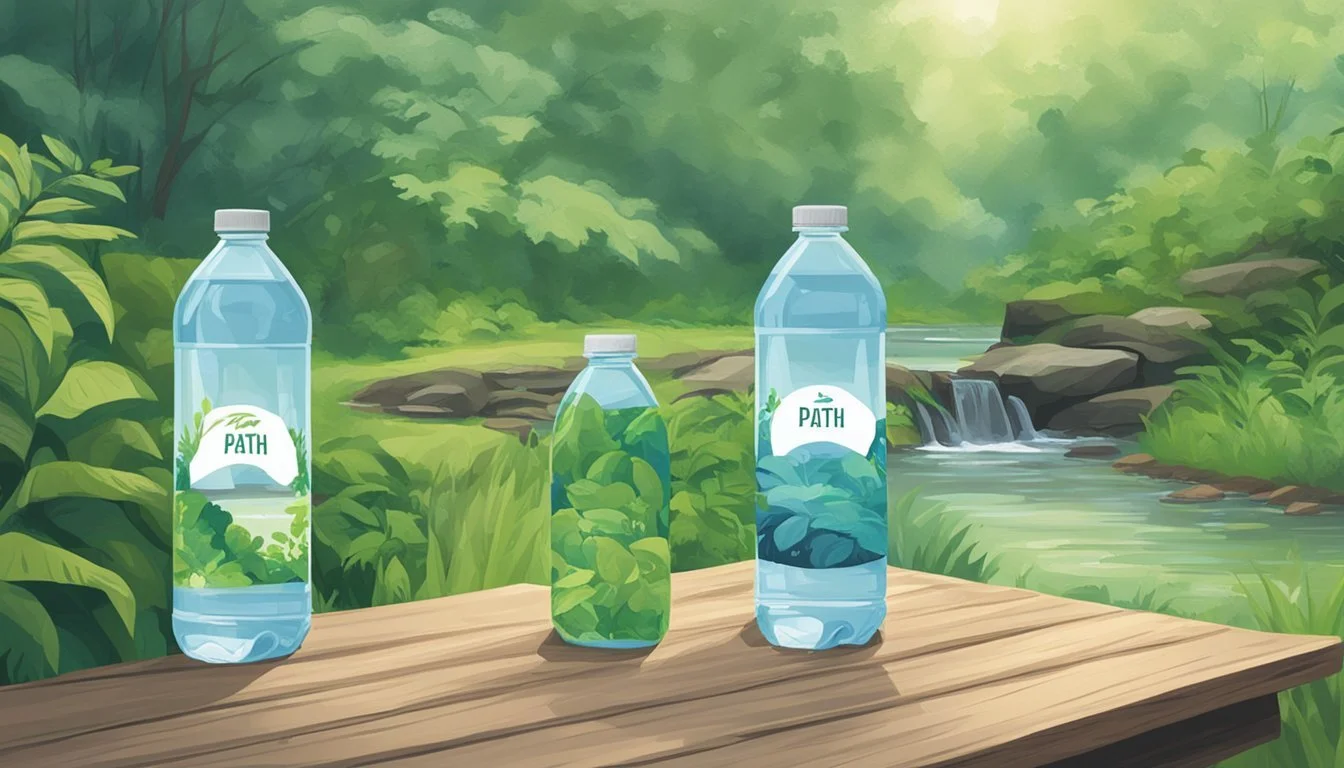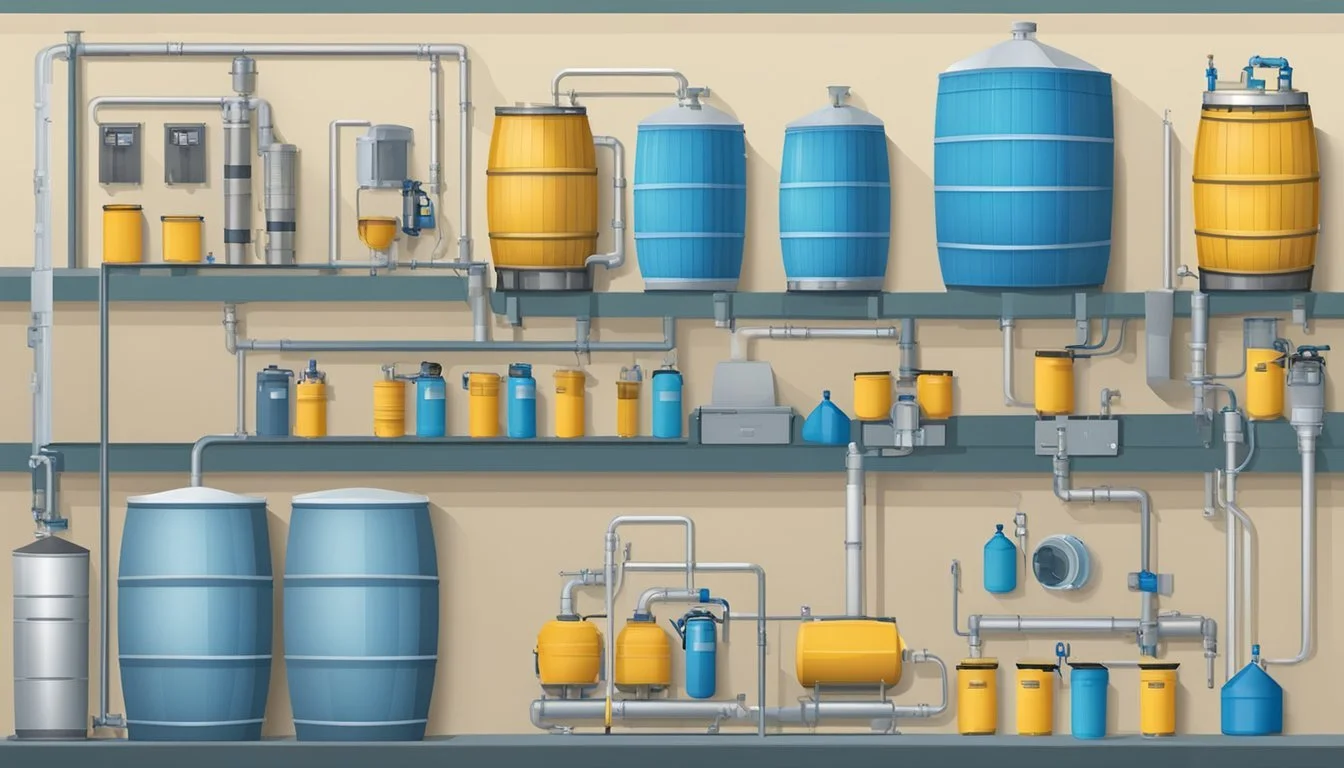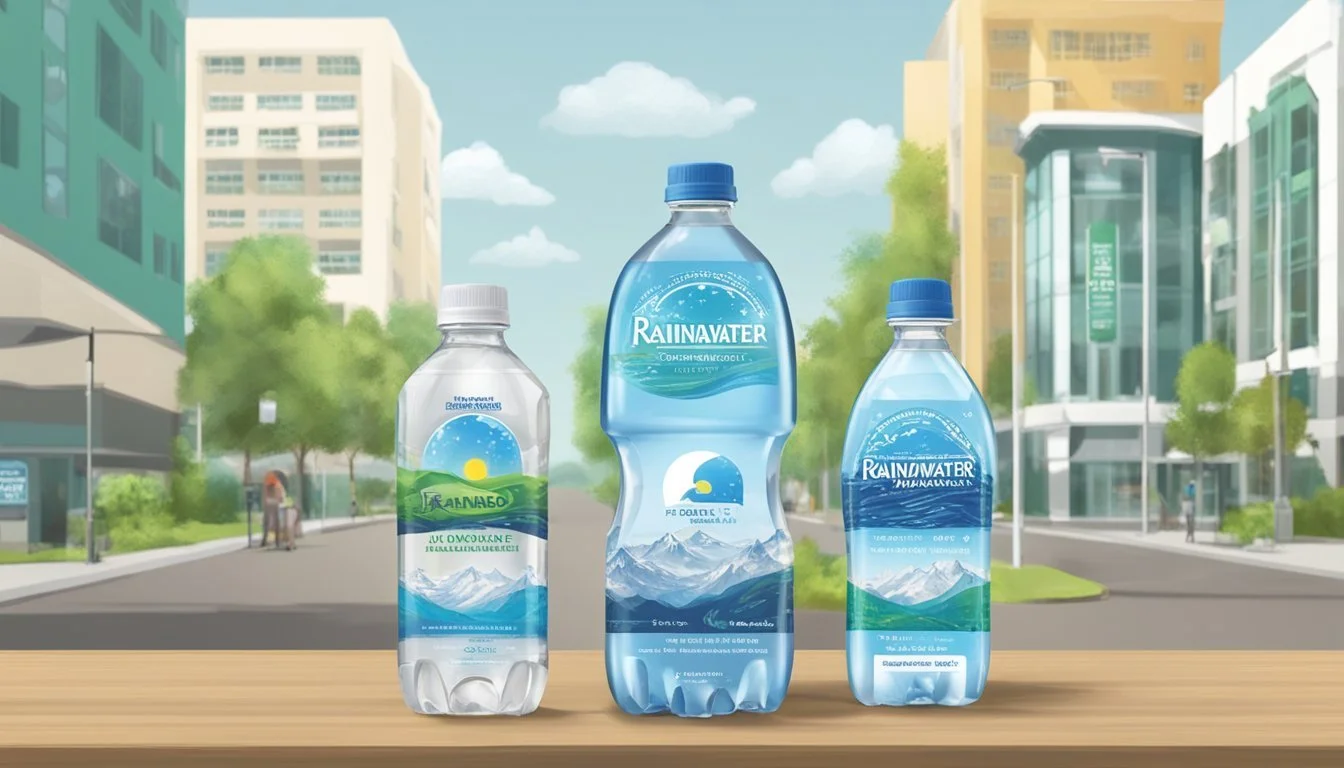Path vs. Richard’s Rainwater
Comparing Bottled Water Quality
Choosing between Path and Richard's Rainwater can be challenging, as both brands bring unique qualities to the bottled water market. While Path offers an eco-friendly approach with reusable aluminum bottles, Richard’s Rainwater focuses on purity by collecting naturally filtered rainwater. Both brands aim to provide clean, refreshing drinking water, but which one is truly better?
For eco-conscious consumers, Path's reusable aluminum bottles stand out as a sustainable solution, reducing plastic waste and providing long-term use. On the other hand, Richard's Rainwater's unique selling point is its source: rainwater. This innovative method claims to offer a taste closer to nature, highlighting its roots from Texas where it all began in 1994. The brand has gained ground, making its way onto the shelves of major retailers like Whole Foods and Kroger.
Comparing the taste, sustainability, and availability of these brands will help determine which bottled water meets your needs. Those seeking a sustainable option may lean towards Path, while those intrigued by the novelty of drinking rainwater might opt for Richard's Rainwater.
The Emergence of Rainwater as a Drinking Water Source
As water scarcity becomes an increasing concern, the innovation of collecting rainwater for drinking purposes has gained traction. This section explores the historical roots, benefits, and comparative quality of rainwater and spring water.
Historical Context and Modern Resurgence
Historically, various civilizations utilized rainwater collection methods for drinking and agricultural purposes. Ancient cultures in arid regions designed systems to capture rain for use during dry seasons.
In recent years, companies have revived this ancient practice with modern technology. Richard's Rainwater, for instance, collects rainwater in Texas and New Orleans, ensuring it remains pure and sustainable for consumption. They employ advanced filtration systems to ensure the water meets potable standards.
Benefits of Harvesting Rainwater for Bottling
Harvesting rainwater presents multiple benefits, particularly in regions facing water scarcity. Rainwater collection lessens the dependency on traditional water sources such as aquifers and municipal supplies, which are often overstressed.
Richard's Rainwater highlights these benefits by capturing stormwater runoff, thereby preventing soil erosion and urban flooding. Their processes contributed to saving over 400k gallons of water last year, providing enough clean water to hydrate 2000 people annually.
Comparative Analysis of Rainwater and Spring Water Sources
When comparing bottled rainwater to traditional spring water, notable differences emerge. Spring water typically comes from underground sources and requires less rigorous filtration due to its natural purity. However, rainwater, starting as atmospheric moisture, can be collected above ground and thus may initially contain more impurities.
In response, companies like Richard's Rainwater employ triple-filtration systems, making potable rainwater as pure as natural spring sources. This method ensures sustainable and high-quality hydration options, appealing to environmentally conscious consumers. Additionally, rainwater's renewability provides a notable advantage over diminishing groundwater sources.
Comparison Table:
Aspect Rainwater Spring Water Source Atmospheric moisture Underground springs Filtration Needed High (Triple-filtration) Moderate (Natural purity) Sustainability Renewable Limited by natural aquifers Environmental Impact Reduces runoff, erosion Possible depletion of sources Example Brand Richard’s Rainwater Path
Given these factors, rainwater offers a viable alternative water source for consumers and communities facing water scarcity issues.
Profile: Richard’s Rainwater
Richard’s Rainwater has emerged as a pioneer in the bottled water industry by harvesting rainwater and focusing on sustainable production. Founded by Richard Heinichen in 1994, the company has grown through innovative practices and strategic retail partnerships.
The Story of Founder Richard Heinichen
Richard Heinichen, the founder of Richard’s Rainwater, started collecting rainwater in his Austin, Texas home during the '90s. Frustrated with the quality of well water affecting his hair and laundry, Heinichen turned to rainwater as an alternative.
Over time, this personal project transformed into a business with the founding of Richard’s Rainwater. Heinichen’s innovative approach was driven by his desire to find a pure and sustainable water source.
Sustainable Production Practices
Richard’s Rainwater emphasizes sustainability at every step of its production. The company captures rainwater and subjects it to a proprietary, zero-waste filtration system. This method ensures that more water is available for consumption compared to traditional sources.
Using recyclable aluminum cans and glass bottles, Richard’s Rainwater aims to minimize environmental impact. This commitment extends to their operations at partners like Faubourg Brewing Co., where efforts are made to reduce the carbon footprint.
Richard’s Expansion and Retail Partnerships
Richard’s Rainwater has seen significant growth through strategic partnerships with major retailers such as Whole Foods Market, Kroger, and Sprouts. These collaborations have expanded their market presence, making still and sparkling rainwater more accessible to a broader audience.
The company offers its products in various sizes, including 16 oz. aluminum cans and 750ml glass bottles for still water, and 12 oz. glass bottles for sparkling water, catering to diverse consumer preferences. Through these partnerships and product offerings, Richard’s Rainwater continues to maintain a presence in the competitive bottled water market.
Profile: Path Water
Path Water is known for its focus on sustainability and the use of innovative aluminum bottles. It is committed to reducing the environmental impact typically associated with single-use plastic bottles, aiming to inspire more eco-conscious consumer habits.
Innovative Aluminum Bottles and Environmental Ethos
Path Water utilizes recyclable aluminum cans for its bottled water, which distinguishes it from many competitors in the bottled water industry. Aluminum is not only lightweight and durable but also has a much higher recycling rate compared to plastic. This choice aligns with the company's broader environmental sustainability goals.
In addition to promoting recyclable materials, Path Water encourages consumers to refill their bottles, reducing waste and promoting a sustainable lifestyle. Their mission is reflected in the slogan #refillit, and they actively engage with their audience through social media platforms like Instagram to spread this message. By advocating for the reduction of single-use plastics, Path Water plays a part in addressing water scarcity and environmental degradation.
Path's Market Presence and Distribution
Headquartered in the U.S., Path Water has established a solid market presence across various retailers. The company's products are available in major supermarkets, health stores, and online platforms, making their eco-friendly options accessible to a broad audience. Path Water's strategic partnerships and widespread distribution channels are key to its growth in the competitive bottled water industry.
Their distinctive branding and aluminum packaging resonate with consumers seeking sustainability-focused products. By targeting environmentally conscious customers, Path Water has built a loyal following and raised awareness about the environmental impact of single-use plastics. This market strategy has cemented its role as a pioneer in the shift towards more sustainable bottled water solutions.
Health and Quality Considerations
Understanding the health and quality of bottled water is essential for making informed choices. Key points include water purity, regulatory standards, and addressing contaminants such as lead, microplastics, chlorine, and fluoride.
Evaluating Water Purity and Filtration Methods
Water purity and filtration are paramount in bottled water quality. Richard's Rainwater captures rain directly before it makes contact with surfaces, preserving natural purity and minimizing potential contaminants.
In contrast, many bottled water brands, such as those in the study showing 64% of bottled water is just tap water, may undergo basic filtration yet still contain various impurities. Water filtration systems are also essential, impacting overall purity and taste.
Comparing these methods helps consumers appreciate the simplicity and effectiveness of using natural sources like rainwater versus municipal tap water.
Regulatory Standards for Bottled Water
Bottled water quality hinges on meeting various regulatory standards. In the United States, both federal and state regulators oversee bottled water safety. The Food and Drug Administration (FDA) sets national standards, while states may impose additional regulations.
Richard's Rainwater aligns with these stringent requirements to ensure safety and quality. It's crucial to note that despite the rigorous regulatory framework, discrepancies still exist, notably the consumer report highlighting contaminants in bottled water. Adherence to these standards assures consumers of the product’s reliability.
Addressing Water Contaminants: Lead, Microplastics, Chlorine, and Fluoride
Contaminants pose significant health risks if not adequately managed. Richard's Rainwater's process inherently minimizes exposure to elements like lead, frequently a concern in municipal supplies, as underscored by the Flint, Michigan crisis.
Moreover, microplastics, chlorine, and fluoride are common in bottled water but less so in naturally collected rainwater. Consumers must scrutinize bottled water labels and choose brands that test for and mitigate these contaminants effectively. An informed choice prevents intake of these harmful substances, safeguarding health.
Environmental Impact and Sustainability
When comparing the environmental impact and sustainability practices of Path and Richard’s Rainwater, it’s essential to look at their carbon footprints, sources of water, and packaging choices. Both brands have unique approaches to conserving resources and reducing ecological harm.
The Carbon Footprint of Bottling and Logistics
Bottled water production has varying impacts on the environment. Richard’s Rainwater, by capturing rain before it hits the ground, uses a process that minimizes contamination and the need for extensive purification. However, the logistics of bottling and transporting this water do contribute to CO2 emissions. For instance, producing a standard 50 oz of bottled water can release anywhere from 1.6 to 22 oz of CO2.
Path also faces similar challenges. Energy consumption in bottling and logistics significantly impacts their carbon footprint. Though specifics on Path’s carbon emissions are less documented, the general consensus is that substantial emissions result from transportation and bottling processes.
Renewable Water Resources and Conservation
Richard’s Rainwater leverages one of the most renewable resources: rainwater. By collecting rain, they utilize a natural and frequent part of the water cycle, helping to conserve groundwater and prevent urban runoff contamination. This method contributes to the avoidance of depleting non-renewable water sources, thus aiding sustainability efforts.
Path, in contrast, sources water from traditional groundwater or purified sources, which can tap into non-renewable aquifers. Conservation claims by Path would center on efficiency and reduced wastage in their bottling process. However, the lack of reliance on a renewable source like rainwater is a notable difference in their sustainability approach compared to Richard’s Rainwater.
Packaging Choices and Ecosystem Considerations
Packaging has a significant environmental footprint, especially regarding plastic vs. glass. Richard’s Rainwater typically uses infinitely recyclable glass bottles, reducing long-term environmental harm. Glass, though heavier and more energy-intensive to transport, poses fewer recycling challenges compared to plastic.
Path, traditionally using plastic bottles, faces more considerable scrutiny. Plastics contribute heavily to environmental contamination, particularly in oceans and ecosystems. Efforts to use more eco-friendly materials or recycled plastics can mitigate some impact, but plastic's intrinsic environmental challenges remain. Exploring alternatives like compostable materials or moving towards recyclable options could benefit Path’s sustainability profile.
Both companies have room for improvement, and their ongoing efforts to address environmental impacts are key to their sustainability journey.
Market Dynamics and Consumer Behavior
Understanding consumer behavior and the dynamics of the market is crucial in comparing Path and Richard’s Rainwater. This involves analyzing where consumers are most likely to purchase these products and how online platforms influence their buying decisions.
Sales Channels and Consumer Access: From Whole Foods to Independent Grocers
Sales channels play a critical role in the distribution of Path and Richard’s Rainwater. Both brands are widely available in major retailers such as Whole Foods Market, which emphasizes natural and sustainably-sourced products. Path often collaborates with big retailers and distributors to ensure the availability of their water in multiple outlets.
Richard’s Rainwater also leverages partnerships with natural grocers and independent grocers to maintain a unique position in the market. Stores like H-E-B and other regional market players are essential for their distribution strategy. This allows both brands to reach a broad audience, from health-conscious consumers to eco-minded shoppers.
Online Presence and Marketing: Driving Sales Through Platforms Like Instagram
Both Path and Richard’s Rainwater utilize social media to boost their sales and branding. Instagram is a dominant platform for their marketing efforts, where both brands showcase their sustainability initiatives and engage with their audience. Path often features influencer partnerships and user-generated content to build community trust and foster brand loyalty.
Richard’s Rainwater, on the other hand, emphasizes their unique rainwater bottling process in their posts. Engaging storytelling, educational content, and strategic ad placements drive consumer interest. Additionally, their online stores and e-commerce partnerships expand their customer base beyond traditional brick-and-mortar retailers, ensuring ease of access for tech-savvy shoppers.
Local and Global Considerations
Path and Richard’s Rainwater present unique approaches in sourcing and marketing their bottled water. One focuses on regional aquifers while the other taps into renewable rainwater sources, impacting how each brand is perceived locally and globally.
Impact of Regional Water Sources on Brand Image
Path sources its water from natural springs and regional aquifers. These sources are often associated with high-quality and cleaner water. Products that come from well-known rainiest cities in the United States might carry a stronger brand image for reliability. For example, areas like Seattle and New Orleans have a reputation for ample rainfall, adding to the credibility of Richard’s Rainwater.
Richard’s Rainwater takes a different approach by collecting rainwater before it hits the ground. This method is crucial in areas with frequent water shortages, as it highlights sustainability. The company’s ability to provide pure water while mitigating storm runoff positions it favorably in regions facing environmental challenges.
Water Scarcity and Global Efforts Towards Sustainable Sources
Global water scarcity is a concern driving both brands towards innovative solutions. Path depends on underground aquifers and springs, which can be strained by climate change and increased demand. This reliance may face criticism when aquifer levels drop, affecting both local ecosystems and long-term availability.
Richard’s Rainwater, relying on rainfall, addresses climate change impacts by utilizing a renewable resource. This is particularly important in regions where ground and surface waters are scarce. The method aligns with global efforts for water sustainability, reducing pressure on traditional water sources and contributing to a more sustainable water consumption model.
The global recognition of sustainable water practices enhances Richard’s Rainwater's image, making it appealing in international markets that prioritize environmental responsibility. Conversely, Path's dependence on finite natural sources might be seen as less adaptable to changing global water dynamics.
Cultural Relevance and Community Influence
Both Path and Richard’s Rainwater have established significant cultural relevance and community influence through their unique approaches to bottled water and meaningful community engagements.
Water Brands and Their Connection to Local Communities
Richard’s Rainwater stands out with its origin story rooted in Texas since 1994. The brand’s commitment to sustainable water practices resonates strongly within the southeast communities, establishing a positive local impact. Their efforts to bottle 100% potable rainwater using a proprietary, virtually zero-waste filtration system have gained admiration.
Path takes a different approach by emphasizing eco-friendly packaging and carbon neutrality. They connect with communities by promoting sustainability and reducing plastic waste. Their mission aligns with a global push towards environmental consciousness, enhancing their appeal across diverse localities.
Collaborations and Partnerships With Premier Restaurants, Bars, and Coffee Shops
Richard’s Rainwater has successfully partnered with various premier restaurants, bars, and coffee shops. Their presence in these establishments not only boosts brand visibility but also integrates the message of sustainability directly within consumer experience in popular and influential locations.
Path collaborates with top-tier restaurants, hotels, and cafes, reinforcing their brand's dedication to quality and environmental stewardship. These strategic partnerships help Path gain endorsements from renowned culinary and hospitality sectors, further solidifying their place in the market and enhancing their cultural relevance.
The influence of both brands extends through these partnerships, highlighting their commitment to sustainability and community engagement. This approach is crucial for building enduring relationships with consumers and local businesses.
The Future of Drinking Water
Innovations in water filtration and sustainability efforts are pivotal to the future of drinking water. Bottled water companies are increasingly focused on creating cleaner, more accessible water for communities while minimizing environmental impact.
Innovations in Water Filtration and Purification
Water filtration systems have significantly advanced, ensuring the highest quality of clean water. Richard’s Rainwater, for instance, uses a virtually zero-waste filtration system to make rainwater potable. This system is not only sustainable but also efficient in providing more drinking water compared to conventional sources.
Net-positive approaches, like those adopted by Richard’s Rainwater, ensure that these advancements contribute positively to the environment. Such methods are crucial for meeting the growing demands for clean water globally. Innovations in purification can also support disaster-stricken areas and communities lacking access to safe drinking water.
Trends Shaping the Path Forward for Bottled Water Companies
The trends in the bottled water industry are driven by a combination of consumer preferences and environmental awareness. One notable trend is the emphasis on sustainability. Companies are striving to reduce plastic waste and carbon footprints through the use of biodegradable packaging and local sourcing, which cuts down on transportation emissions.
Furthermore, the distribution strategies are evolving. Brands are focusing on providing clean water to underserved communities and ensuring that their operations do not deplete local water resources. This includes leveraging community-based distribution networks to enhance access to safe drinking water.
Consumer packaged goods (CPG) companies in the bottled water sector are also expanding their product lines to include enhanced and functional waters, catering to health-conscious consumers. The integration of advanced filtration and purification technologies with eco-friendly practices is set to drive the industry forward.
More About Path
Mountain Valley Spring Water vs Path: Which Bottled Water is Better?
Path vs Whole Foods Italian Still Mineral water: Which Bottled Water is Better?
More About Richard’s Rainwater
Acqua Pana vs Richard's Rainwater: Which Bottled Water is Better?
Alkaline88 vs Richard's Rainwater: Which Bottled Water is Better?
Antipodes vs Richard's Rainwater: Which Bottled Water is Better?
Aqua Carpatica vs Richard's Rainwater: Which Bottled Water is Better?
Aquafina vs Richard's Rainwater: Which Bottled Water is Better?
Arrowhead vs Richard's Rainwater: Which Bottled Water is Better?
Boxed Water vs Richard's Rainwater: Which Bottled Water is Better?
Cascade Mountain vs Richard's Rainwater: Which Bottled Water is Better?
Castle Rock vs Richard's Rainwater: Which Bottled Water is Better?
Cirro vs Richard's Rainwater: Which Bottled Water is Better?
Richard's Rainwater vs HFactor: Which Bottled Water is Better?
Core Hydration vs Richard's Rainwater: Which Bottled Water is Better?
Crystal Geyser vs Richard's Rainwater: Which Bottled Water is Better?
Deer Park vs Richard's Rainwater: Which Bottled Water is Better?
Erewhon vs Richard's Rainwater: Which Bottled Water is Better?
Essentia vs Richard's Rainwater: Which Bottled Water is Better?
Eternal vs Richard's Rainwater: Which Bottled Water is Better?
Ethos vs Richard's Rainwater: Which Bottled Water is Better?
Evian vs Richard's Rainwater: Which Bottled Water is Better?
Hawaii Volcanic vs Richard's Rainwater: Which Bottled Water is Better?
Hawaiian Springs vs Richard's Rainwater: Which Bottled Water is Better?
Ice Mountain vs Richard's Rainwater: Which Bottled Water is Better?
Icelandic Glacial vs Richard's Rainwater: Which Bottled Water is Better?
Just Water vs Richard's Rainwater: Which Bottled Water is Better?
Kroger vs Richard's Rainwater: Which Bottled Water is Better?
LIFEWTR vs Richard's Rainwater: Which Bottled Water is Better?
Liquid Death vs Richard's Rainwater: Which Bottled Water is Better?
Mananalu vs Richard's Rainwater: Which Bottled Water is Better?
Mountain Valley Spring Water vs Richard's Rainwater: Which Bottled Water is Better?
Nestle Pure Life vs Richard's Rainwater: Which Bottled Water is Better?
Origin vs Richard's Rainwater: Which Bottled Water is Better?
Ozarka vs Richard's Rainwater: Which Bottled Water is Better?
Penta vs Richard's Rainwater: Which Bottled Water is Better?
Perrier vs Richard's Rainwater: Which Bottled Water is Better?
Poland Spring vs Richard's Rainwater: Which Bottled Water is Better?
Purely Sedona vs Richard's Rainwater: Which Bottled Water is Better?
Richard's Rainwater vs 1907water: Which Bottled Water is Better?
Richard's Rainwater vs 7-Select: Which Bottled Water is Better?
Richard's Rainwater vs Action: Which Bottled Water is Better?
Richard's Rainwater vs Big Chill: Which Bottled Water is Better?
Richard's Rainwater vs Big Win: Which Bottled Water is Better?
Richard's Rainwater vs BodyArmor: Which Bottled Water is Better?
Richard's Rainwater vs CBD Living: Which Bottled Water is Better?
Richard's Rainwater vs Crystal Lake: Which Bottled Water is Better?
Richard's Rainwater vs Dasani: Which Bottled Water is Better?
Richard's Rainwater vs Essence pH10: Which Bottled Water is Better?
Richard's Rainwater vs Kirkland Signature: Which Bottled Water is Better?
Richard's Rainwater vs Open Water: Which Bottled Water is Better?
Richard's Rainwater vs Ophora: Which Bottled Water is Better?
Richard's Rainwater vs Proud Source: Which Bottled Water is Better?
Richard's Rainwater vs Pure Life: Which Bottled Water is Better?
Richard's Rainwater vs Ramona: Which Bottled Water is Better?
Richard's Rainwater vs Refreshe: Which Bottled Water is Better?
Richard's Rainwater vs Simple Truth: Which Bottled Water is Better?
Richard's Rainwater vs Skyra: Which Bottled Water is Better?
Richard's Rainwater vs Talking Rain AQA: Which Bottled Water is Better?
Richard's Rainwater vs The Well: Which Bottled Water is Better?
Richard's Rainwater vs Weird Water: Which Bottled Water is Better?
Richard's Rainwater vs Whole Foods 365: Which Bottled Water is Better?
Richard's Rainwater vs Zenwtr: Which Bottled Water is Better?
San Pellegrino vs Richard's Rainwater: Which Bottled Water is Better?
Smartwater vs Richard's Rainwater: Which Bottled Water is Better?
Solan de Cabras vs Richard's Rainwater: Which Bottled Water is Better?
Starkey vs Richard's Rainwater: Which Bottled Water is Better?
Tahoe vs Richard's Rainwater: Which Bottled Water is Better?
Topo Chico vs Richard's Rainwater: Which Bottled Water is Better?
Tru Alka vs Richard's Rainwater: Which Bottled Water is Better?
Volvic vs Richard's Rainwater: Which Bottled Water is Better?
Waiakea vs Richard's Rainwater: Which Bottled Water is Better?
Whole Foods Italian Still Mineral water vs Richard's Rainwater: Which Bottled Water is Better?
Zephyrhills vs Richard's Rainwater: Which Bottled Water is Better?








